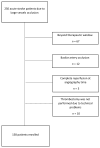Predicting Factors of Functional Outcome in Patients with Acute Ischemic Stroke Admitted to Neuro-Intensive Care Unit-A Prospective Cohort Study
- PMID: 33256264
- PMCID: PMC7761293
- DOI: 10.3390/brainsci10120911
Predicting Factors of Functional Outcome in Patients with Acute Ischemic Stroke Admitted to Neuro-Intensive Care Unit-A Prospective Cohort Study
Abstract
Although thrombectomy is beneficial for most stroke patients with large vessel occlusion (LVO), it has added new issues in acute management due to intensive care support. In this prospective cohort study, we described the patients admitted to our neuro-intensive care unit (NICU) after thrombectomy in order to assess factors linked to functional outcomes. The outcome was independency assessed for stroke patients consecutively admitted to NICU for an ischemic stroke due to LVO of the anterior cerebral circulation that underwent intra-arterial mechanical thrombectomy (IAMT), either in combination with intravenous thrombolysis (IVT) in eligible patients or alone in patients with contraindications for IVT. Overall, 158 patients were enrolled. IVT (odds ratio (OR), 3.78; 95% confidence interval (CI), 1.20-11.90; p = 0.023) and early naso-gastric tube removal (OR, 3.32; 95% CI, 1.04-10.59 p = 0.042) were associated with good outcomes, whereas a high baseline National Institutes of Health Stroke Scale (NIHSS) score (OR, 0.72 for each point of increase; 95% CI, 0.61-0.85; p < 0.001) was a predictor of poor outcomes at 3 months. Older age (OR, 0.95 for each year of increase; 95% CI, 0.92-0.99; p = 0.020) and hemorrhagic transformation (OR, 0.31; 95% CI, 0.11-0.84; p = 0.022) were predictors of poor outcomes after IAMT, whereas a modified Treatment in Cerebral Infarction (mTICI) score of 2b/3 was a predictor of good outcomes (OR, 7.86; 95% CI, 1.65-37.39; p = 0.010) at 6 months. Our results show that acute stroke patients with LVO who require NICU management soon after IAMT may show specific clinical factors influencing short- and long-term neurologic independency.
Keywords: acute ischemic stroke; neuro-intensive care unit; outcome; thrombectomy; thrombolysis.
Conflict of interest statement
The authors declare no conflict of interest.
Figures




References
-
- GBD 2017 Causes of Death Collaborators Global, regional, and national age-sex-specific mortality for 282 causes of death in 195 countries and territories, 1980–2017: A systematic analysis for the Global Burden of Disease Study 2017. Lancet. 2018;392:1736–1788. doi: 10.1016/S0140-6736(18)32203-7. - DOI - PMC - PubMed
-
- Meschia J.F., Bushnell C., Boden-Albala B., Braun L.T., Bravata D.M., Chaturvedi S., Creager M.A., Eckel R.H., Elkind M.S.V., Fornage M., et al. Guidelines for the primary prevention of stroke: A statement for healthcare professionals from the American Heart Association/American Stroske Association. Stroke. 2014;45:3754–3832. doi: 10.1161/STR.0000000000000046. - DOI - PMC - PubMed
-
- Berkhemer O.A., Fransen P.S.S., Beumer D., van den Berg L.A., Lingsma H.F., Yoo A.J., Schonewille W.J., Vos J.A., Nederkoorn P.J., Wermer M.J.H., et al. A randomized trial of intraarterial treatment for acute ischemic stroke. N. Engl. J. Med. 2015;372:11–20. doi: 10.1056/NEJMoa1411587. - DOI - PubMed
LinkOut - more resources
Full Text Sources
Medical

